Abstract
In recent decades, the fight against climate change and the commitment to reduce greenhouse gases have shed a light on the production of energy from renewable sources, in particular those derived from solar energy. This has required the involvement of all stakeholders (producers, but also energy operators, authorities, distributors, and final consumers) which has led to the outline of a new scenario characterized by more efficient technologies, dedicated strategies and business models, and the research of alternatives solutions. Within solar technology, great attention has been given in recent years to concentrating solar power (CSP) technologies, both from research studies and technological development sides. This paper provides a theoretical framework based on a CSP literature review to define the state of the art and to identify research gaps and future research steps related to this technology. The work is based on an innovative bibliometric study to explore technical fields related to CSP, providing both a comprehensive framework with reference to the state of the art of the technology investigated, and a detailed analysis on CSP commercial applications, making the review a very useful tool for stakeholders and decision makers The results of the analysis: (1) help to clarify the technological advances of CSP, the strengths and weaknesses of the current technologies used (parabolic and tower systems are the most widespread), and indications of the prospects for dish systems; (2) identify an alternative to the economic problem that represents an obstacle to the diffusion of CSP, for example, by identifying the ability to couple it with thermal storage as a valid method to increase the flexibility of the system and reduce costs; (3) suggested hybrids, both with renewable and non-renewable technologies, identifying strengths and weaknesses for all the proposed proposals; (4) show that it is possible to identify new ongoing research such as that related to hydrogen production. This paper represents the first part of a larger research study developed within the SOLARGRID Project, which promotes and supports the development of innovative solutions for systems and components for CSP and concentrated photovoltaics (CPV) technologies, with the aim to enhance their energetic performances and economic competitiveness in applications for the distributed generation of both electric and thermal energy frameworks. The main findings of our study highlight that, though there is an increasing number of papers on the topic of CSP, several issues remain neglected.
1. Introduction
Distributed energy resources (DERs) represent technologies that may be integrated at both the supply and demand side of a distribution system (low-voltage or medium-voltage) to satisfy the energy requirements of final users. The DER can be divided into distributed generation (DG), including renewable energy sources (RES); demand response; and distributed storage [1].
In the current evolution from the traditional power system to the smart grid framework, DERs are becoming extremely important, as a massive integration of DG is occurring by changing the infrastructure and the overall layout of the electricity networks [2,3]. Current power systems rely on unidirectional networks designed to manage the energy flows from large conventional generators through the distribution network to end users. With the advent of DG, bidirectional power flows are expected due to numerous generation plants represented by small-size variable renewable sources located along the distribution network [4,5]. Several technical challenges need to be addressed for this shift from traditional power systems to smart grids and these affect both the planning and operation phases. The impact associated with the large-scale penetration of variable RES is so significant that it will require a complete reassessment of grid deployment and operational planning, particularly for frequency response and operational reserve services provision.
According to [6], among the various renewable technologies, it is expected that solar-energy-based systems—concentrated solar power (CSP) and solar photovoltaic systems (PV)—together with wind, will constitute a stable, high percentage of renewable energy generation systems that will be price-competitive with conventional energy sources [7]. Moreover, the development of CSP represents an interesting tool with which to support the power system, providing the additional flexibility it needs [8]. This highlights the increasing importance of solar energy as a reliable and sustainable source for electricity generation, with both PV and CSP technologies playing integral roles in the future energy landscape [7]. Although the PV plants dominate the solar market, accounting for approximately 98% of annual installations employing solar technologies [9], during the same time window, the installed capacity of CSP grew by 149% globally [10]. In 2021, significant milestones were achieved in the worldwide adoption of solar energy, with the deployment of 848.4 GW of PV and 6.4 GW of CSP. Over the past decade, the solar sector has experienced remarkable growth, with a 719% expansion in the global solar market from 104.3 GW in 2012 to 854.8 GW in 2021 [10,11]. In fact, CSP offers several advantages over PV, particularly when it comes to large-scale power plants. Firstly, CSP systems have built-in thermal energy storage capabilities, allowing them to store excess heat generated during sunny periods. This stored thermal energy can be used to generate electricity during cloudy or nighttime conditions, providing continuous power supply, which can be essential for large-scale power plants. Additionally, CSP systems, when tailored for large-scale applications, can achieve higher overall thermal-to-electric conversion efficiencies compared with individual PV installations. This increased efficiency enhances energy capture and conversion. Moreover, CSP’s ability to dispatch electricity on demand makes it a reliable contributor to grid stability. It seamlessly integrates with other energy sources and aligns with various demand profiles, effectively matching electricity supply with demand.
Nevertheless, CSP plants are designed with a reduced environmental footprint compared with some PV installations. They typically require less land per unit of electricity generated, reducing land-use conflicts and environmental disruption.
CSP systems can also be easily hybridized with other energy sources, such as natural gas or biomass, to provide consistent power generation. This hybrid approach can improve the reliability and cost-effectiveness of large-scale power plants.
Scalability is another advantage of CSP technology. It can be scaled up to meet the power demand of large-scale facilities, making it well-suited for utility-scale power plants.
Additionally, CSP systems often have a longer operational lifespan compared with PV installations, providing a more extended period of reliable electricity generation.
It is important to note that the choice between CSP and PV depends on various factors, including geographical location, resource availability, project size, and specific energy requirements. While CSP offers advantages for large-scale power plants, PV can be more cost-effective and suitable for distributed generation in some situations.
In this framework, CSP has attracted further attention for its interesting technical and economic characteristics, and its reliability in terms of the continuity and type of the service that it provides [11]. These factors will allow, in the near future, the use of CSP as a basic load regulator to provide energy in a stable way [12].
Furthermore, CSP technology can be more attractive when compared with other RES. In fact, in contrast with hydropower, CSP has not been shown to generate environmental problems or social objection, and it is not overly dependent on source and location parameters [13]. When compared with wind turbines, CSP creates less emissions; while, if compared with PV, CSP has a longer service life [12]. Moreover, unlike PV technology, which directly converts solar energy into electricity, CSP systems utilize mirrors or lenses to concentrate direct normal irradiance (DNI) onto a receiver [14]. This process allows one to directly convert the sunlight in thermal energy at high temperatures that can be converted to mechanical energy first, and then to electricity [15]. Finally, CSP works in a different way to PV in terms of thermal energy storage and generation: this characteristic makes the energy produced by CSP programmable, reducing the volatility (both for production and energy price), and increasing the reliability of the system [16,17,18].
The main contribution of the paper is to provide an extensive review of the status of research activities on CSP. It does so by identifying the research gaps, the main challenges, and the future needs for fostering a massive deployment of this promising technology at the global scale.
This work is based on an innovative bibliometric study that is used to explore technical fields related to CSP, providing a comprehensive framework with reference to the state of the art of the investigated technology and the advances in the research in the field. Moreover, it also provides a detailed analysis on CSP commercial applications, making the review a very useful tool for stakeholders and decision makers to identify the real maturity of the technology [12,17,18,19]. The work has been carried out through research activities and involves the study, definition, and development of new solutions. It does so while considering the integration of distributed energy storage systems into the analyzed systems, as well as hybrid configurations which, while increasing the electricity generation from RES, also use conventional and non-conventional resources. Hybrid solutions, moreover, improve the flexibility of the energy system, and reinforce the reliability of the electricity system. We propose a multi-perspective, multi-level and multi-domain approach that is able to identify drivers and barriers linked to the spread of CSP, but at the same time is also able to consider the interests of all relevant stakeholders in the identification of the best solutions.
The applied methodology is articulated in the following phases: a phase of paper acquisition, a phase of paper selection, and a phase of the descriptive and content analysis of the selected papers. The paper acquisition phase is based on the correct identification of the keywords, which allows us to identify the works on the topic present in the main research databases, ScienceDirect and Web of Science. The second phase aims to identify restrictive criteria that allow us to limit the analysis to a specific number of works. The third phase consists of an extrapolation of the information from the papers and is articulated into: (a) a descriptive analysis in which the papers are aggregated according to different perspectives to give a summary view of the selected papers and (b) content analysis, in which papers are reviewed and studied in detail. The analysis of papers allows us to highlight strengths and weaknesses in the body of literature and evident research gaps.
Among the key results, the primary conclusions drawn from this study underscore the importance of: (a) the growth in research activities in this field; (b) the importance of the “location factor”, not only as parameter to increase the efficiency production, but also as part of a wider framework in which policies, economics and social aspects coexist to guarantee a successful CSP technology integration; (c) the energy price reduction derived from CSP application; (d) desalination; (e) life cycle assessment (LCA); (f) hydrogen production, and the utilization of phase change materials (PCMs); (g) thermal energy storage (TES); and (h) hybridization systems as an investigated research area that represents promising avenues for future research endeavors.
This work has been developed within the SOLAGRID Project (www.solargrid-project.eu), which aims to develop innovative technical solutions for systems and components related to CSP and CPV technologies, in order to increase their energetic performances and economic competitiveness in DG applications, considering electric and thermal energy provision. This general objective is pursued by considering the following specific targets:
- Improvement of energy performance and reliability of systems and individual components of CSP and CPV systems, thanks to the identification and advanced development of technological solutions.
- Increase of the thermal storage capacity and, therefore, of the flexibility of the thermal energy carrier, thanks to the experimentation, modeling, and development of components for energy storage systems. Identification of configurations with a high economic/performance tradeoff and optimization of the parameters of advanced hybridization/integration solutions with conventional and non-conventional energy systems that are equipped with energy storage systems and are integrated into the network.
- Integration of production systems, in the presence of distributed storage and within energy microgrids, for the supply of energy services of an electrical and thermal type, and the consequent development of control and management strategies. Identification of eco-efficient solutions of the different technologies presented, through life cycle costing (LCC) and LCA assessments.
This segment constitutes the initial phase of research conducted as part of the SOLARGRID Project. However, it is essential to note that certain critical areas remain underexplored. The paper is articulated in the follow steps: the literature review that investigates the CSP spread, identifying the main research area from technological, economical. social and environmental points of view. The results and discussion section presents the study’s findings and delves into a detailed analysis of the influence of relevant factors on the development of CSP, accompanied by practical recommendations for fostering its massive deployment. Finally, the conclusions section provides a comprehensive summary of the study’s outcomes and their implications.
2. A Lens of the CSP Research
This section presents a detailed review in regards to CSP, with the aim to understand what the main research areas under investigation are, the applied methodologies, the implemented methods, and future steps for research. The steps of the proposed methodology—the phase of paper acquisition, the phase of paper selection, and the phase of the descriptive and content analysis of the selected papers—are described below.
2.1. Phase of Paper Acquisition: Identification of Keywords
The papers were selected using Scopus and Web of Science databases. The keywords “concentrated solar power” or “CSP” or “Concentrating solar power” were combined with “solar energ*” AND renewable energ*”, which are the most frequent author keywords in the abstracts and titles of the publications of the investigated topic, as shown in Figure 1. The * allowed us to consider terms and words both in singular and plural forms. A total of approximately 1000 papers were identified across both databases, with duplicate works duly removed, spanning the years 1999 to 2023. The annual scientific production is displayed in Figure 2, highlighting the discernible growth in interest over time that is indicated by the observed trend. Subsequent results were obtained and assessed utilizing R packages, specifically focusing on bibliometrics toolkit [20].
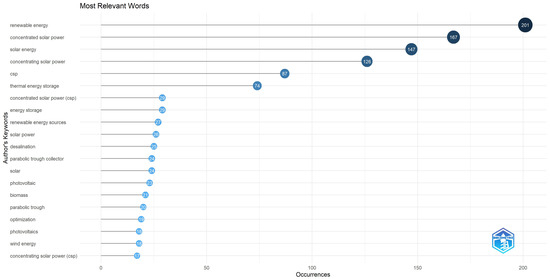
Figure 1.
Most frequent author keywords.
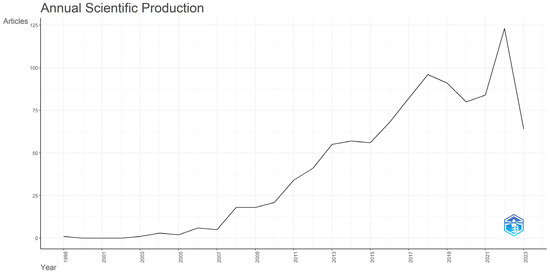
Figure 2.
Annual scientific production.
This paper replicates the previously described analysis, as illustrated in Figure 3, conducted with both the author’s keywords and additional ‘Keywords Plus’ terms. These ‘Keywords Plus’ terms are defined as words or phrases frequently occurring within the titles of a paper’s references but not present within the paper’s own title. In accordance with [21], we recognize that authors keywords better represent the content of the articles and focuses on the specific field, but ‘Keywords Plus’ describe better the framework in which the paper is inserted and also involves research methods and techniques. For this reason, in this work ‘Keywords Plus’ represent a unit of analysis with which to understand the context and the current research area, and also to identify possible new fields to investigate.
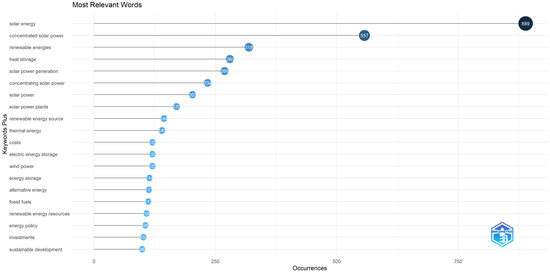
Figure 3.
Most frequent ‘Keywords Plus’.
Indeed, upon a comparative examination of the obtained results, initially with the authors’ keywords and subsequently with the ‘Keywords Plus’ terms, it became evident that, among the presently most prominent author-derived keywords, notable terms include ‘parabolic trough’, ‘thermal energy storage’, ‘optimization’, and ‘desalination’. However, energy policy, electric storage costs and investments are subsidized, indicating that they might not be currently relevant to the research topic. It is more interesting, however, to notice that, between relevant words, there is also “energy policy”, highlighting how the geographic and social contexts are relevant aspects in terms of the support for the spread of CSP.
2.2. Phase of Paper Acquisition: Description Criteria
Within the dataset of 1000 selected papers, it is possible to extract essential information, such as title, authorship, country of publication, journal source, publication year, and the number of citations. These data elements collectively constitute the core components for identifying and pinpointing works closely related to the subject matter. In order to circumscribe the analysis, the following criteria are applied:
- -
- Data range reduction, establishing the review in a period from 2013 to 2023.
- -
- Language of publication: only works published in the English language were considered.
- -
- Source type: only papers published (or submitted) to scientific journals were considered.
- -
- Number of citations for the different publications.
- -
- Reviews were not considered in the analysis, in order to identify only specialized articles.
Under this hypothesis, 491 works were identified, and during 2022 the number of publications was significant (90 papers), as can be seen in Figure 4.

Figure 4.
Trend of publications over time.
2.3. Phase of Descriptive and Content Analysis of the Selected Papers
Source production over time is shown in Figure 5. Renewable and Sustainable Energy Review, Solar Energy and Energies are the three journals from which most of the articles have been published recently and that are recognized as highly specialized into the science and technology of solar energy applications. Thus, they are particularly relevant for publications focused on the topic of CSP. In Table 1 are summarized the main topic of each journal, and the number of works published by each of them.

Figure 5.
Source production over time.

Table 1.
Main journals focused on CSP.
Figure 6 provides a ranking of the most prominent authors in relation to the number of scientific publications within the specified topic: classification identifies the authors as recognized experts within the field. Figure 7 presents a ranking based on the number of citations garnered. Our analysis of the abstracts enabled the categorization of authors’ works, with a focus on delineating their respective areas of interest and the applied research methodologies, as delineated in Table 2.
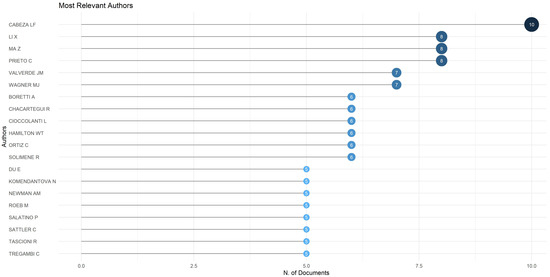
Figure 6.
Most relevant authors.
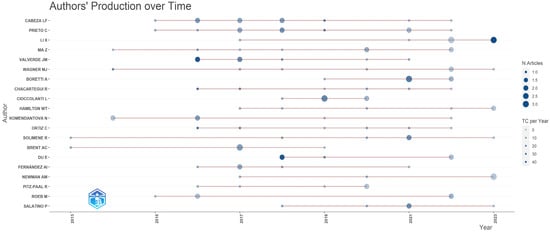
Figure 7.
Authors’ production over time.

Table 2.
Main authors and their research area.
After an in-depth analysis of the title and abstract of the selected paper, an analysis of the co-occurrences has been developed using R, in particular its bibliometric package. The co-occurrence analysis works on the identification of the most relevant words and phrases for a given topic inside the test. It is a bivariate analysis that does not work on the recurrence of single words belonging to a specific category, but on the contingencies of words of different categories, returning the relationship between words within the test. Thanks to this analysis it is possible to understand the relationship between the words and to deepen the research based on these relations. The analysis returns the identification of three main clusters: green, blue, and red, with the green cluster being the largest of them. Each circle in the figure is a keyword, and the size of the circle represents the number of times in which a keyword is used as a term in the publication. The distance between the keywords indicates whether keywords are more frequently correlated with each other (short distance) or whether they do not co-occur (largest distance). Betweenness centrality, closeness centrality, degree and page-rank measures are considered in the analysis, where betweenness centrality measures the number of the shortest paths going through a node; closeness centrality calculation scores each node based on their ‘closeness’ to all other nodes in the network, i.e., the number of steps required to access all other nodes starting from a given node; degree represents the number of adjacent edges; and page rank assigns nodes a score based on their connections, and their connections’ connections, taking link direction and weight into account—so links can only pass influence in one direction, and pass different amounts of influence. The betweenness shows which nodes are ‘bridges’ between nodes in a network, classifying them into peripherals, which are intermediate of central nodes in terms of the function of the value of the assigned index. This allows for the identification of which node is the bridge in a network. Usually, the node with higher betweenness centrality is the master, which means that it has more control over the network because it collects the most amount of information. The closeness measure calculates the shortest of the paths between all nodes, measuring the distance between the vertices of a graph. The page-rank measure uncovers nodes whose influence extends beyond their direct connections into the wider network. This is an important measure by which to identify the importance of the node to the network [22].
The results of the analysis are shown in Figure 8, while in Table 3 are shown the social network centrality measures used and their values. Walktrap is an algorithm that follows an approach based on random walks by R software. The principle at the basis of the random walks is that the walks are more likely to stay within the same community than outside of it [21].
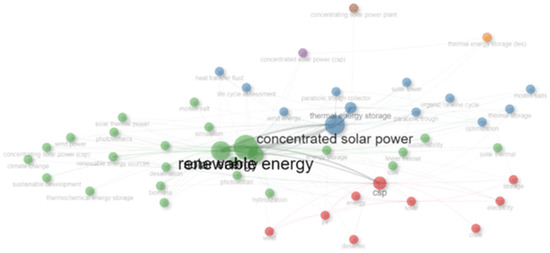
Figure 8.
Co-occurrence map.

Table 3.
Cluster details.
The first, green, cluster, has “renewable energy sources” as its main keywords, but also PV, wind, biomass, and hybridization. This cluster includes review papers that analyze the benefits deriving from the choice of a CSP plant in the RES framework development, but which also identify innovative solutions such as hybridization, or hydrogen production.
The second cluster is the red one, which includes keywords such as PV, storage wind, but also desertic and Chile. In this cluster there are papers that analyze the integration between CSP and other renewable sources, but another key factor also emerges for the diffusion of CSP, which is the geographical factor. Consequently, within this cluster there are works in which the advantages and disadvantages of installing the CSP in a particular geographical area will be analyzed, and in which tools such as GIS will find widespread use.
The significance of the geographic factor becomes readily apparent through an examination of publications originating from various countries. The USA and Spain are global leaders in CSP electricity generation, whereas developing countries such as China and India are emerging. China is the most active country, both in terms of number of publications and developed projects. European countries show an important interest in the topic, with Spain, Italy, France, Denmark, Austria, and the United Kingdom collectively contributing to 36% of the total published papers. Among these, Spain has distinguished itself with particularly noteworthy achievements in advancing research on the subject. China stands out as a significant contributor, accounting for 15% of the total publications, while the United States closely follows with 14%. Furthermore, countries like the United Arab Emirates, with 2% of the publications, underscore the global resonance of the CSP development theme, as depicted in Figure 9a and Table 4.
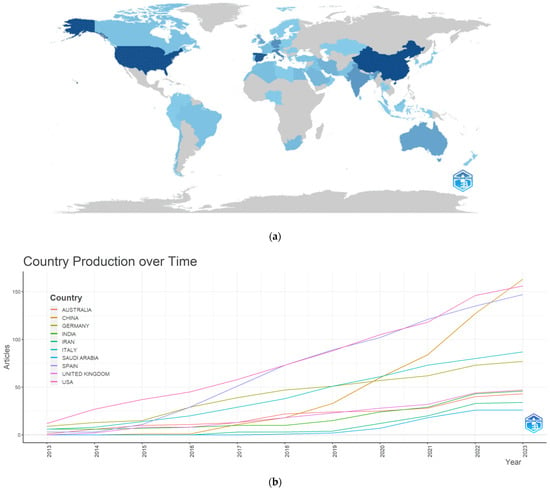
Figure 9.
(a) Country’s scientific production. (b) Country’s scientific production.

Table 4.
Regional production.
In Figure 9 and Figure 10, the darker colors represent the countries most interested in the topic and with the highest production of publications. This is shown in greater depth in Figure 9b, where each country’s scientific production is shown.

Figure 10.
Country collaboration map.
Collaborations represent the best way to share knowledge between countries with more knowledge of CSP technologies, and countries that have more interest in developing and promoting the diffusion of this technology. Thus, it is important to deepen the research collaboration between countries, as shown in Figure 10 and in Table 5. China has consolidated and developed strong collaboration research links with the United Kingdom, USA, and European countries, but has also developed new partnerships with Australia, Denmark and Egypt. Although CSP does not represent the most competitive power plants for China’s energy strategy, the Chinese government has, however, decided to focus on this technology with a view to environmental sustainability, reduction of polluting emissions, and flexibility of the service provided. This is indicated by the China Renewable Energy Development Roadmap 2050, through which the Chinese government has committed to meeting an ambitious target in which China will install 180 GW of CSP plants in 2050 against the 5 GW at present and the 30 GW planned for 2030 [23,24]. Collaborations between all European countries are evident, with Spain being the most active to the CSP spread and whose interests reach as far as South America, Chile.

Table 5.
Country collaboration.
The economic forecast of CSP investment costs represents an important driver to support decision makers because high cost is the main factor hindering its large-scale development. This is the reason that many studies use the learning curve model to predict such costs [24].
Finally, there is the blue cluster, which includes keywords such as Rankine cycle, molten salt, levelized energy costs (LCOE), life cycle analysis (LCA), and thermochemical energy storage. Here are grouped studies of technological, but also environmental, social and economic improvements, identifying barriers to overcome and future research prospects. From our point of view, it is not possible to prospectively analyze the future and the development of a technology without considering the economic aspects and, consequently, also the technological improvements. This is the reason for which research on the ranking cycle is currently widespread. Organic Rankine cycle (ORC) power systems stand out in terms of efficiency, reliability and cost-effectiveness in such power-range. However, the results obtained must be placed in a context that cannot ignore compliance with the constraints. The LCA methodology is a consolidated technique for assessing environmental impacts. What emerges from what has been said is the importance of analyzing the different aspects, not separately, but as a single body. In particular, the outcomes of the literature review highlight that, although CSP power systems have already been widely analyzed from the techno-economic and environmental perspective, these analyses have been carried out separately. Therefore, there is a strong need for an integrated approach that allows designers and planners to perform an overall sustainability assessment of the technology. For instance, economic and environmental optimization could be cross evaluated to select the design method that is the most sustainable from all perspectives.
The co-occurrence map allows one to understand the maturity of the research themes, subdividing them into basic, motor, niche and emerging (Figure 11).
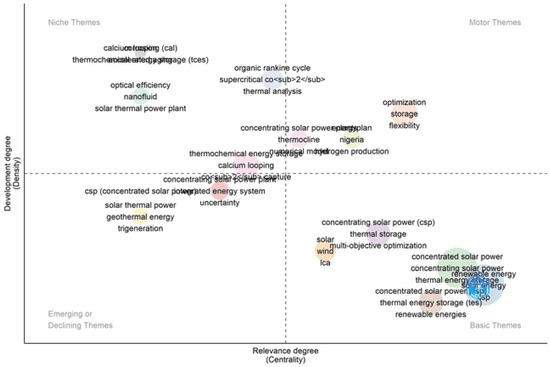
Figure 11.
Identification of themes.
The figure indicates that, for CSP, basic themes that deal with field are solar, wind, renewable energies, and thermal energy storage, while flexibility, optimization, hydrogen production, and storage represent motor themes. Nanofluid, organic ranking, and calcium looping, are, indeed, niche research themes. Finally, trigeneration, and geothermal energy coupled with solar technology are emerging themes [25].
There is a clear opportunity for the researchers here to bridge and overcome the common aspects of CSP technology development by taking into account various factors, such as the LCOE, and/or methodologies for assessing potential RES integration. There is also a need to comprehend the new economic framework in which electricity generation develops, one that also considers how technological knowledge is gathered from solar collector and thermal-energy storage research.
2.4. Citation Analysis
Citation analysis is a widely accepted method that can establish links and relationships to other works or researchers by examining the frequency of citations, patterns and graphical representations in article and books. The analysis of the citations shows what are the more relevant works in this field, considering the number of citations as a measure. In Figure 12 are shown the first 20 papers and their respective authors.
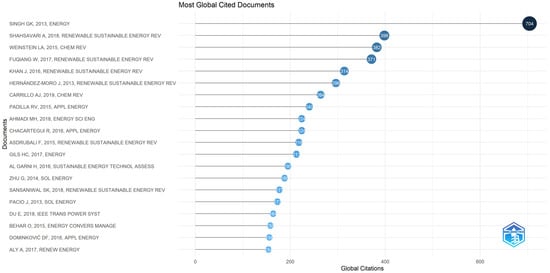
Figure 12.
Citation analysis results [16,25,26,27,28,29,30,31,32,33,34,35,36,37,38,39,40,41,42,43].
The results of the analysis show that the most cited articles are those of generic reviews. In particular, Refs. [16,26,27,28,32,37,38,40,44] focus on the role of the generation of energy from solar technologies. References [25,42,43] underline the importance of the geographical aspect for the diffusion of CSP technology, while [30,31,33,39] refer to the technological aspects and the efficient configuration. Refs. [29,34] to delve deeper into the LCOE analysis and its role for the near future; Finally, the optimization models are shown in references [35,36,41].
The selected papers belong to the literature review field and, since analyzing their content, it is evident that there is a strong interest from the research community for the development of solar technology, and that CSP technology may be the most important technology for the near future.
Though, as the authors underline, the considerations made cannot go beyond the policies adopted by each country, the characteristics of the country itself and the support tools for the various technologies, CSP technology seems to be particularly suitable for systems of great powers, and for those where there is a need to satisfy thermal and electrical loads simultaneously. More details are shown in the next section.
3. Comparison of CSP Technologies
CSP technologies can be broadly classified in several ways. Usually, it is possible to cluster CSP in to line focusing and point focusing groups [45] or, depending on the geometry and design of the concentrator in relation to the receiver, it is possible to distinguish among CSP in plants with linear parabolic collectors, plants with parabolic disc collectors, and central tower plants.
Systems that employ line-focused solar concentration, as demonstrated by parabolic troughs and linear Fresnel reflectors, utilize long and curved mirrors to concentrate solar radiation onto a receiver tube positioned along the focal axis. The heat transfer fluid circulates within the receiver tube, and, when exposed to concentrated sunlight, produces thermal energy to generate steam, which, in turn, powers a turbine for electricity generation. On the other hand, point-focusing systems, including power towers and dish–Stirling systems, concentrate sunlight onto a single point or small area. Power solar tower systems use an array of mirrors or heliostats to direct sunlight towards a central receiver placed at the tower’s summit. The receiver absorbs the concentrated sunlight by transferring the resulting thermal energy to a heat transfer fluid, which is subsequently utilized for steam generation and electricity production.
In the global progression of CSP technology, the most mature approach currently applied for thermodynamic solar electricity production is the deployment of linear parabolic troughs. However, the most innovative and promising technology is the parabolic dish, even if dish configurations with energy storage systems are currently still in the prototype phase.
In terms of cost, tower and dish systems are more expensive, but in the near future technological innovations are expected that will make them capable of reducing the leverage cost of energy, LCOE. In terms of land occupation, tower and Fresnel technologies require less space when compared with the same output obtained via parabolic trough systems. However, the dish technology has the smaller footprint [45,46].
Dish–Stirling systems, as shown in Figure 13, use a paraboloidal collector to reflect and concentrate incoming solar radiation onto the focal point, where the power conversion unit (PCU) is located [13].
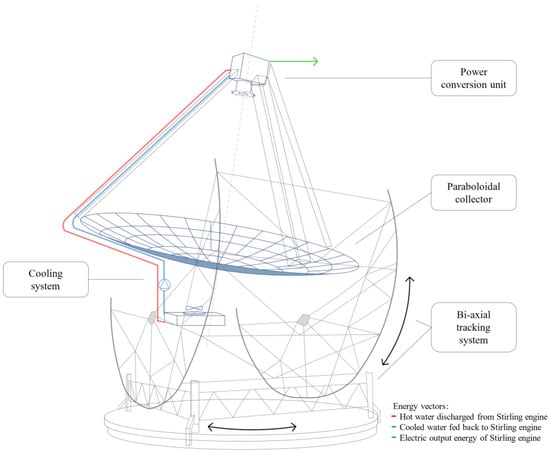
Figure 13.
Illustrative sketch of a CSP parabolic dish system.
This is achieved through a bi-axial solar tracking system that is able to align the focal axis with the direction of sunrays by following the solar position throughout the day. The PCU consists of a receiver, an engine for converting thermal energy into mechanical energy (typically a Stirling engine or a micro-turbine), and an electrical generator for the final step of converting mechanical energy into electricity. While the receiver maintains the high temperature level of the thermodynamic cycle by providing heat to the hot chamber of the Stirling engine, a cooling system removes the necessary heat from the cold chamber of the same engine, dissipating it into the environment to maintain the lower temperature level of the cycle [47].
In general, the performance of CSP systems is significantly influenced by various factors, including the external air temperature, DNI level and soiling factor of the mirror surface [48]. Among these, one crucial factor is the DNI level, which depends mainly on the geographical location. As can be noted from the solar resource map of Figure 14, Sun Belt regions, Middle East and North Africa (MENA), Australia, Chile, southwestern Europe, and South Africa, tend to offer favourable conditions for CSP systems due to the abundance of direct sunlight [44,49]. These geographical areas host all of the currently operational, non-operational, and under-construction CSP projects identified by Solar Power and Chemical Energy Systems (SolarPACES) [50].
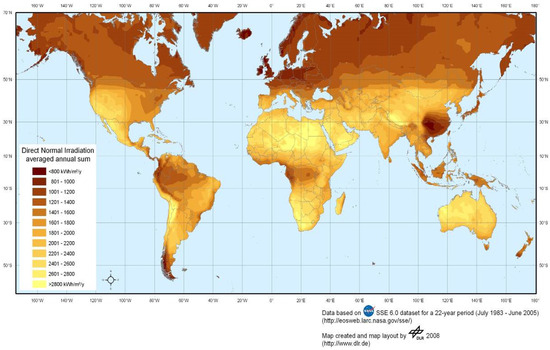
Figure 14.
Concentrating solar power global potential map [50].
Dish–Stirling systems stand out among various CSP technologies due to their distinctive advantages, making them an enticing option for solar energy production. One notable advantage is their high geometric concentration factor. The parabolic shape of the reflector enables the concentration of incoming solar radiation onto a small focal point, resulting in increased energy intensity and higher temperature limits. As a consequence, in terms of energy efficiency, dish–Stirling solar concentrators hold the record for conversion efficiency from solar energy to electricity under nominal conditions [44]. Another advantage of dish–Stirling systems is their modular design. They can be constructed in a modular manner, allowing for flexibility and adaptability to different energy generation requirements. This feature makes them suitable for a range of applications, from small-scale power supply for communities to large-scale power generation facilities [51]. Furthermore, dish–Stirling systems make efficient use of land compared with other solar technologies thanks to their high concentration efficiency [51,52]. Finally, dish–Stirling systems exhibit adaptability for diverse applications, including cogeneration; integration with heating, ventilation, and air conditioning technologies in residential buildings; combination with thermal energy storage; or hybridization with other renewable energy sources. They are also well suited for electricity generation in remote rural areas and centralized power generation, as well as for producing desalinated water [52].
Despite these advantages, dish–Stirling systems are the least widespread among CSP technologies [52], as indicated by the data collected by SolarPACES. The SolarPACES database records information on a total of 129 CSP projects worldwide, with parabolic troughs accounting for 73.9% of the projects, power towers for 22.5%, linear Fresnel for 3.6%, and parabolic dish systems making up only 0.04%, for a total capacity of 3 MW (refer to Figure 15).
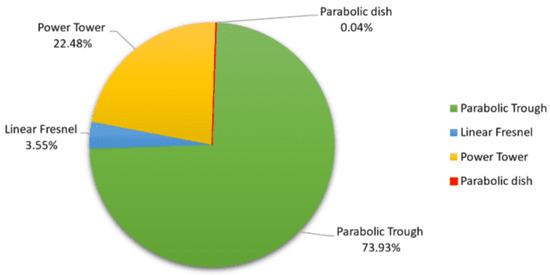
Figure 15.
SolarPACES data on concentrating solar power (CSP) projects around the world by technology [46].
Furthermore, 58% of CSP projects using parabolic troughs (62% with a storage capacity exceeding 7 h), 48% of projects utilizing linear Fresnel reflectors (62% with a storage capacity exceeding 7 h), and 68% of power tower projects are integrated with thermal storage systems (43% with a storage capacity exceeding 7 h), allowing for extended energy production periods. However, it should be noted that CSP projects employing parabolic dish systems do not include thermal storage [53,54].
The relatively low global adoption of dish–Stirling systems can be ascribed to multiple factors, including the substantial initial expenses linked to the intricate parabolic dish design and Stirling engine components. Moreover, dish–Stirling technology is not as mature as other CSP technologies, such as parabolic troughs and power towers. It is still in the early stages of commercialization and faces challenges in terms of reliability, durability, and overall performance [52,54]. In addition, one of the challenges associated with dish–Stirling systems is the difficulty of integrating them with thermal energy storage systems. These factors make dish–Stirling systems less economically viable for large-scale deployment [44,53].
Considering the economic aspect and the limited availability of reliable literature data on the costs of the dish–Stirling technology, an assessment of the market penetration of CSP technologies can be conducted by analyzing the actual expenses associated with the construction of a 32 kW dish–Stirling demonstration plant located at the University of Palermo campus, in Italy [54]. The total installed cost breakdown of this dish–Stirling CSP plant is shown in Figure 16.
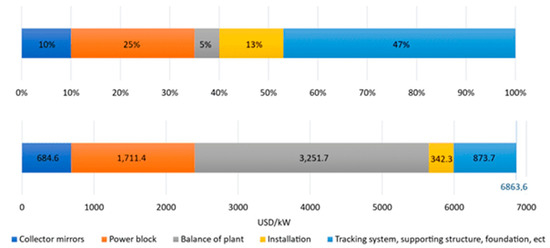
Figure 16.
Total installed cost breakdown of a dish–Stirling CSP plant [52].
Referring to this dish–Stirling reference system, the total installed cost per unit of dish–Stirling technology amounts to USD 6863.6/kW. Of this cost, 47% is attributed to the tracking system and support structure, while 25% is assigned to the power block expenses. The result is not satisfactory, and the technology is less effective when compared with that of parabolic troughs, especially large ones, which have already reached technological maturity.
Furthermore, considering the Mediterranean region as a hypothetical installation site (with a direct normal irradiation of about 2100 kWh/m2/year), the optimized configuration of the reference system exhibits an estimated annual electricity production ranging from 54 to 63 MWh [44], corresponding to levelized cost of electricity (LCOE) values between 0.45 and USD 0.40/kWh [29,55,56,57]. Comparing these values with the data collected by the International Renewable Energy Agency (IRENA) on total installed costs and LCOE for CSP (parabolic trough, linear Fresnel, and power tower) and PV technologies [29], as shown in Figure 17, several observations can be made: (i) dish–Stirling systems are not yet competitive with other widely adopted CSP technologies on the market, when considering that the global average total installed cost for CSP in 2020 was USD 4746/kW; (ii) mature CSP technologies themselves are not competitive in terms of initial investment costs compared with PV technology (which has a total installed cost of USD 857/kW and LCOE of USD 0.048/kWh in 2021), which has itself experienced significant technological advancements and widespread adoption in recent years.
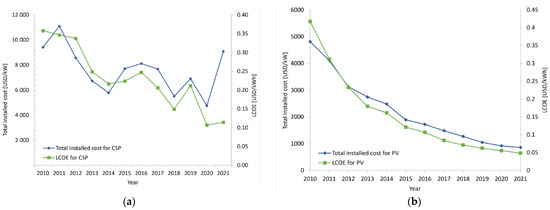
Figure 17.
Average global total installed costs and LCOE for CSP (a) and PV (b) on a weighted scale, 2010–2021 [29].
Considering more favorable locations for CSP system installation, characterized by direct normal irradiation levels of 2500 kWh/m2/year, with the optimized configuration of the reference dish–Stirling system, it would be possible to achieve an LCOE of USD 0.26/kWh. This value is closer to the LCOE achieved by CSP technologies in 2021 (USD 0.11/kWh) [29,57].
In conclusion, the development of dish–Stirling technology and its widespread adoption require several key factors to be addressed. Technological advancements have a pivotal role in improving the efficiency, reliability, and overall performance of dish–Stirling systems. Moreover, dish power plants involve some structural disadvantages related to the presence of the medium–heavy tip receiver. Firstly, the complexity of tracking mechanisms is a significant concern. Solar dish systems rely on highly precise tracking mechanisms to follow the sun’s movement accurately. The intricacy of these mechanisms can lead to substantial installation and maintenance costs. Furthermore, solar dish systems often incur high capital costs. The precision needed for mirrors and tracking systems can lead to a substantial initial investment, potentially acting as a barrier to widespread adoption, especially in smaller-scale applications. Another challenge is the lack of built-in energy storage capabilities. Solar dishes usually require additional energy storage solutions, such as batteries or thermal storage systems, to ensure an uninterrupted power supply. This adds complexity and cost to the overall system. Additionally, solar dish systems produce electricity only when the sun is shining, leading to intermittent energy production. This limitation can be problematic for applications requiring continuous power or in regions with variable weather conditions. The scalability of solar dish systems is also a consideration. They are typically designed as modular units intended for smaller-scale applications. Expanding them to achieve utility-scale power generation may require complex interconnections of multiple dish units. Despite these challenges, solar dish technology continues to hold promise, especially in applications requiring high temperatures or concentrated solar power. Ongoing research and development efforts aim to address these limitations and enhance the competitiveness and feasibility of solar dish systems for various energy needs.
Continued research and development efforts are necessary to enhance the technology’s competitiveness and overcome existing challenges. Furthermore, policies, incentives, and financial support can encourage the adoption of dish–Stirling technologies, accelerate their market penetration, and push towards the initiation of economies of scale to make dish–Stirling technology more economically viable for large-scale deployment. By addressing these aspects, the path to widespread adoption of dish–Stirling systems can be paved, unlocking their full potential in contributing to the worldwide shift to cleaner and sustainable energy sources.
4. Results and Discussion
The benefits of using CSP technology include the promise of cost-effective investment, mature technology, and the ease of its combination with fossil fuels or other renewable energy sources.
Electricity produced by a CSP plant depends on the amount of solar radiation received normally per unit area by a surface, also known as the direct normal insolation. Thus, in accordance with [43,58,59,60], our work highlights how the location represents an important variable in the decision-making process, especially for countries with an abundance of the solar resources needed to secure their energy supply, reduce their carbon footprint and consequently achieve sustainable development goals. In particular, [43] shows an in-depth analysis used to identify the main techno-economic criteria that impacted the best location choice for large-scale solar technology in Tanzania. The results were obtained using GIS tool and MCDC techniques to identify the best criteria to define the exclusion of some areas and to show the area in which CSP represents the best technology to use, as well as other areas best suited for PV.
In [58,59,60], the following emerges: that CSP has huge potential in South Africa; that Europe, in particular Spain, is the first of region to install commercial CSP plants; and that Asia has the second-highest number of CSP plants, with the power tower being the most prominent CSP technology in this region and molten salt the preferred thermal storage to be coupled with CSP plants. There are also examples of plants that prefer water as a heat transfer fluid, but that a site with a nearby water source represents an important constraint for an efficient CSP plant. Australia is one of the best prospective areas for CSP, given the linear relation between the area occupied by the plants and the electricity generated; however, uncertainties over cost and economics has delayed the deployment of CSP plants in this region [58]. Hybridization strategies, also correlated with the location aspect, form an important research field in terms of the many benefits that they can provide. Hybridization can improve overall efficiency, reduce capital costs and increase the flexible operation by synergy with other, different, energy sources. Additionally, different configurations can be implemented. CSP coupled with coal, natural gas, biofuel, may represent an important opportunity to use solar heat at different temperatures, to improve flexibility or to increase the reliability of the system; however, it does not represent an environmentally friendly solution. Otherwise, a hybrid system in which CSP, coupled with RES as PV, wind or geothermal powerplant, respects the emissions constraints but is less efficient in terms of dispatchability and planning activities. The best configuration is CSP–PV, although this technology is still not mature enough and is at an initial commercialization stage. The main expected outcomes deriving from this type of hybridization can be summarized as offering better power quality, better efficiency, and lower costs [61]. However, the configuration is not efficient in term of dispatchability because PV and CSP production is derived from an intermittent resource [62]. A solution to the problem is represented by TES [63,64], whose medium and large size may represent a future solution to make CSPs more economically competitive and dispatchable [65]. In contrast, [66] shows that small-scale CSP plants are not economically compatible with a TES.
As regards the research and development side, many are working on improving the efficiency of CSP plants and on new thermal storage systems. In [31], published by Applied Energy, several analyses are conducted for power plants on four different cycle configurations—simple Brayton cycle (BC), Brayton and recompression (RC), partial cooling and recompression (PC) and recompression with intercooling (MC). Results show that the BC has the lowest efficiency, but is easiest to implement and so is still a valid alternative. The addition of supplemental heating to the Brayton S–CO2 cycle improves thermal and exergy performance, and represents a promising option for solar central receiver systems due to the high thermal efficiencies compared with conventional steam Rankine cycles. In the framework of thermochemical energy storage (TCES) in concentrating solar power (CSP) plants, the calcium-looping (CaL) process, has received increasing research interest for its beneficial properties. In fact, when compared with other storage systems, this allows one to (i) avoid solidification as the compounds can be stored at an environmental temperature; (ii) to store at ambient temperature and avoid heat loss; (iii) to increase the energy density of the system; and (iv) to reach higher maximum temperature [34,45]. Furthermore TES, when combined with CSP plants, offers the opportunity to make these plants economically competitive and reliable during their operation and balance the supply and demand of energy by reducing the undesirable impacts of the solar energy intermittency. In [33], published always by Applied Energy, and in [67], thermal storage application is addressed. In particular the paper introduces a storage system for CSP plants based on the calcium-looping process (CaL), considered a mature technology for thermal input powers ranging from small values to greater than 100 MWth. Results show that it is possible to reach efficiencies of up to 45%; that in these processes there is a complete absence of CO2 released from the system; and that the main parameters to improve the cycle are the pressure ratio in the Brayton turbine and the efficiency of the boiler/reactor/heat exchangers without which the pressure losses associated with CSP–CaL integration would reduce the cost of the levelized cost of electricity. In [26], published in Chemical Reviews, is presented a review of the main TCS systems, paying particular attention to those used at high temperatures (500–1000 °C) and based on redox reactions. The results demonstrate that, for next-generation CSP plants operating with volumetric air receivers, the potential of redox-based thermochemical heat storage is an efficient thermal energy storage option. However, further innovations on material performance, on increasing reactor efficiency, and on implementing more optimal integration strategies are expected in the short term, which could also lead to an overall reduction of CSP plant cost and an increase in the share of solar electricity generation. The first and second papers in terms of the number of citations [16,25] provide an overview of solar technologies, in particular PV and CSP. These environmental terms shed light on and offer opportunities to overcome the barriers impeding solar diffusions at all different levels. Indeed, the authors identify, in power quality and in the relevant uncertainty, links to the main barriers associated with solar energy production for an appropriate planning and operational energy system. In [27], published in Renewable and Sustainable Energy Reviews, the PV and CSP technologies are compared. This work shows that, for the same size, CSP produces more energy than a PV, so could be more convenient. However, the installation costs are higher than a PV system. In conclusion, although the authors recognize the power of the CSP and the advantages derived from it, especially in the near future, the obtained results show that a perfect recipe to decide which is the best solar power plant to use does not exist, because there are too many variables to consider. These include the locations in which the power plant is installed, the policy of the specific country, the several applications, the size of the power plants and, consequently, the load to satisfy.
In [27,32,46,68,69,70], CSP technological aspects are dealt with. In particular, ref. [32] investigates the benefits derived by the application of CSP when compared with PV, reaching the conclusion that, although it is not possible to provide an absolute answer, CSP is often better than PV technology for larger sizes of power plant and in countries characterized by an arid climate. Moreover, although CSP investment costs are higher when compared with PV power plants, the economic returns of CSP plants are better. In addition, the maintenance costs of CSP and PV power plants are 2 and 1%, respectively. Higher maintenance cost of CSP plants is due to its more complicated mechanism. Related to the different CSP technologies, the authors identified the parabolic trough concentrator as the best solution, because it is more efficient in comparison with linear Fresnel reflectors, although the required investment costs are higher. Direct steam generation (DSG) is a process by which steam is directly produced in the CSP parabolic trough (PTC) and supplied to a power block for electricity production. This process improves the cost-effectiveness of the CSP, and can be used in other thermal applications, such as sterilization processes and desalination evaporator supplies [45,71,72,73]. In fact, CSPs, producing both electricity and thermal energy, represent one of the best technologies with which to open the new field of desalinization technologies and fight serious water scarcity. The problem is relevant for CSP technologies in which energy production is linked to the irradiation parameter. This means that the best places to install CSPs are locations in which there is water scarcity. Moreover, as has been highlighted several times, CSPs require an important amount of water to work correctly while respecting the efficiency rate. As a result, techniques of water management are extremely important for the CSP. Phase-change materials (PCM) represent a valid solution to low-cost and high-energy TES systems. They have lower capital costs than two-tank molten salt systems and have been studied in two difference configurations: with shell and tubes at high enough temperatures, or with packed bed storage tanks with the PCM usually encapsulated in balls. The hydrogen production cost is dominated by the cost of energy production.
In [41], published in Energy Conversion and Management, a new model is proposed with which to optimize the design and the operation of the CSP. The authors identified three major parameters on the design of such a collector: the geometric concentration ratio, the acceptance angle, and the rim angle. Therefore, the investigation of the optical and thermal interaction between the neighboring surfaces of the PTC (absorber tube–envelope and envelope–mirrors) and its effect on heat loss is strongly recommended for further research. The authors of [25] recognized in the high temperature an important challenge for parabolic trough technology, and to overcome this problem other methods are introduced to obtain higher energy from the sun, such as applying a parabolic dish concentrator; however, this technology is not very dispersed, and is used for high temperature application.
From economic perspectives, the cost of CSP represents an important obstacle to commercialization. Research has demonstrated that CSP has a large potential in the LCOE reduction that depends not only on the cumulative installed capacity but also on the learning curves impacted by technical progress and experience accumulation [74]. Moreover, it is crucial to select sites with higher direct normal irradiation and land cost exemption in order to improve the cost–benefit evolution of CSP. Lastly, the expected returns (i.e., discount rate) have important effects on the LCOE evolution of CSP, with high expected returns leading to higher LCOE, and vice versa [29].
Finally, previous studies have found that the thermal energy storage (TES) application may decline the LCOE of CSP [29,64,65,66]; increasing TES capacity not only improves the capacity factor, but also adds initial costs. Therefore, optimized research on the TES capacity is crucial for the maximization of the cost–benefit ratio of CSP.
Another research line inside the techno-economic study of solar-electrolysis-based hydrogen production techniques has been carried out. The results indicate that the cost of hydrogen production is dominated by the cost of hydrogen related to the cost of energy production. This cost is highly dependent on solar fraction and solar insolation. The results also show that solar CSP-based hydrogen production techniques are more competitive than conventional PV-based hydrogen production techniques but are as competitive or less competitive than CPV-based hydrogen production techniques [74,75].
The global trade of green hydrogen will probably become a vital factor in reaching climate neutrality. The sunbelt of the Earth has a great potential for large-scale hydrogen production. Additionally, in this case, combining PV with concentrated solar power (CSP) and TES seems to be a good pathway by which to reach more electrolyzed full-load hours and thereby lower the levelized costs of hydrogen (LCOH).
An important line of research on RES technologies is associated with the environmental benefits. One of the main methodologies by which to evaluate environmental impacts is life cycle analysis (LCA). LCA is a consolidated methodology, standardized by ISO 14040 [76] and ISO 14044 [77], by which to evaluate the environmental impacts of products and systems. The principle of LCA is that the environmental burdens of all technologies are distributed over their life cycle stages (i.e., production, operation, end of life). Accordingly, although CSP technologies do not imply direct greenhouse gas (GHG) emissions to the environment, LCA allows one to quantify the impacts attributed to manufacturing and waste management of such systems. In addition, LCA models return several environmental impact indicators beyond life cycle GHG emissions, such as environmental toxicity indicators, and natural resources depletion. The LCA study published in [32] demonstrates that CSP technology has an intermediate environmental profile compared with other renewable energy systems. CSP power plants are shown to be less impactful than photovoltaics and several other renewable energy systems. From the economic perspective, in [27] the authors propose a mathematical model by which to evaluate the life cycle of both PV and CSP technologies. The authors identified 12 variables that influence the determination of LCOE, such as the initial costs, the lifetime of the technology, the operation and maintenance costs, the solar irradiation value, the external temperature, and the discount rate. Results show that, notwithstanding the relevant initial investment costs, the LCOE of CSP is expected to decrease in the near future, thus becoming competitive in the market. Moreover, the discount rate is a very important variable that can influence the decision to invest in this technology. Overall, CSP systems are generally recommended to supply thermal and electrical load simultaneously, especially in countries with an arid climate and in high DTI countries.
Several LCA studies assessing the environmental performances of CSP have been published in the scientific literature so far; to the best of our knowledge, 25 publications are available in international journals or conference proceedings since 2011. A literature analysis was carried out based on the Scopus and Google Scholar databases. In particular, the following keywords combination was used: Dish Stirling, Power Tower, LCA, Parabolic through, Fresnel, CSP.
A wide summary of the above-mentioned literature studies is shown in Table 6, which classifies such publications based on the type of article (i.e., literature or research studies). Table 6 shows that 14 publications address the LCA of parabolic systems, 9 papers regard the environmental analysis of solar towers, only 5 papers discuss the LCA of solar dishes, and that the environmental analyses regarding Fresnel installations amount to 3. More specifically, the environmental analyses that focus on solar tower technologies have been increasing recently. Data reliability and availability represent critical issues in the LCA field. Despite the importance of providing detailed background data to validate and replicate the model, reproducible life cycle inventories (LCIs) are frequently missing in published scientific papers. This fact is demonstrated by the literature analysis proposed in this work; in particular, the research studies collected in Table 1 can be classified as follows:
- Six LCA research studies contain a complete LCI comprising Ecoinvent processes [78] (a).
- Nine LCA research studies contain an aggregated LCI containing the bill of materials with different levels of detail (b).
- Five LCA research studies do not provide an LCI (c).
Table 6 highlights how the most replicable datasets, addressed with the letter a, are mostly based on existing plants (the installation site is indicated in parentheses). This issue is particularly critical for the solar dish and Fresnel CSP power plants. According to reference [79], which is cited in Table 6, is the only research study that contains a reproducible inventory for them. Therefore, the expansion of the number of existing power plants represents a relevant research topic. Corona et al. [61,80,81] published a number of papers about the CSP plant “Ibersol”, located in Spain, and discussed the potential effects of the systems’ hybridization with fossil resources. Burkhardt et al. [82,83,84] applied LCA to two CSP installations respectively placed in Dagget and Maricopa (USA). Ref. [79] compared four existing CSP systems belonging to different technological clusters. Other LCA studies about real-world CSP plants that are currently operating in Italy [85], South Africa [86,87] and China [88] are also available in the literature.


Table 6.
Literature review summary regarding LCA of CSP systems.
Table 6.
Literature review summary regarding LCA of CSP systems.
| References | Power Plants | Rated Power | LCI |
|---|---|---|---|
| Research Papers | |||
| [82] | Parabolic (Dagget) | 103 MW | b |
| [84] | Parabolic (Archimede) | 1.58 MW | b |
| [78] | Dish | 1 kW | c |
| [89] | Parabolic | 2.61 MW | c |
| [90] | Parabolic | 110 MW | b |
| [79] | Parabolic, Fresnel, Tower, Dish (Andasol, Gemasolar, Puerto Errado, Maricopa) | 50, 20, 30, 1.5 MW | a |
| [84] | Tower (Tucson) | 106 MW | b |
| [61,80,81] | Parabolic (Ibersol) | 50 MW | a |
| [59] | Tower | 180 MW | a |
| [91] | Parabolic | 50 MW | b |
| [31] | Heat transfert fluid | - | b |
| [86] | Tower (Khi Solar One) | 101 MW | c |
| [54] | Parabolic (KaXu Solar One) | 100 MW | b |
| [92] | Storage materials | - | a |
| [86] | Tower (Shouhang Dunhuang) | 10 MW | a |
| [93] | Dish | 1 kW | c |
| [94] | Parabolic | 86 kW | c |
| [64] | Tower | 110 MW | a |
| Reviews | |||
| [81] | Parabolic, Fresnel, Tower, Dish | Review | c |
| [95] | Parabolic, Tower, Dish | Review | c |
| [96] | Parabolic, Fresnel, Tower, Dish | Review | c |
| [97] | Parabolic, Tower | Review | c |
| [98] | Parabolic | Review | c |
Among all of the selected LCA studies (20), 16 papers provide comparable results: notably, the results are expressed using the same functional unit, that is 1 MWh of electricity throughput. Nevertheless, these studies can differ in the life cycle impact assessment (LCIA) method and the environmental indicators that are used to evaluate the eco-profiles. A single score is adopted in a small number of studies (i.e., three analyses) as a representative indicator by which to assess the environmental performance of solar thermal power plants. For instance, the “Eco-indicator 99” and “Impact2002+” LCIA methods return impact values that are approximately equivalent to two eco-points (Pt) per MWh [68,91] and 0.01 Pt/MWh [59], respectively. Each of the other 13 papers adopt midpoint environmental impact indicators:
- Thirteen research analyses calculate GHG emissions (9.8–311 kg CO2eq/MWh); the main environmental hotspots are given by the combustion of fossil fuels in hybrid power plants, the solar field manufacturing, and the direct electricity demand of ventilators in dry-cooled for heat dissipation systems.
- Six research analyses calculate the cumulative energy demand (26–1337 MJ/MWh), which is remarkably affected by the choice to deploy fossil fuel-assisted CSP power plants.
- Three research analyses use the energy payback time (EPBT) to cross evaluate the electricity produced by the system and the energy embedded by the power plant during its life cycle (1–3.58 years).
- Six research analyses evaluate water use (1.1–277 m3/MWh). The main contributor to this impact category is the water use during cleaning maintenance operations.
- Three research studies calculate the freshwater ecotoxicity (306–1600 g 1,4-Dbeq/MWh) and human toxicity potential (10–126 kg 1,4-Dbeq/MWh); four studies instead include the marine ecotoxicity calculation (208–1579 g 1,4-Dbeq/MWh).
- Four research studies include the assessment of terrestrial acidification and eutrophication that are respectively assessed to (166–1686 g SO2eq/MWh) and (9.4–84.8 g P eq/MWh).
- Three research analyses evaluate the indicator of land use (4–70 m2/MWh).
- Two publications involve the fossil depletion impact category (estimated to be 8.11–9.29 kg oileq/MWh for solar-based plants and 123 kg oileq/MWh for gas-integrated installations).
- One research paper evaluates the category of photochemical oxidant formation (213–800 g NMVOC/MWh) as well as the environmental burden of particulate matter formation (89.1–524 kg PM10/MWh).
Among all indicators, global warming potential (GWP) is shown to be the indicator adopted by the majority of authors to express the environmental burdens of CSP systems. GWP results emerging from the literature analysis are shown in Figure 15. According to this figure, there is a high variability that can be observed in the literature in terms of life cycle GHG emissions. The results depend on the choice of integrating solar energy with other non-discontinuous sources of energy. For example, Corona et al. (2014) [80] cross-evaluated a solar-based parabolic installation and a CSP plant assisted with fossil fuels in which the contribution of natural gas to the overall electricity production is 35%. Moreover, the chart in Figure 18 shows that solar tower power plants that have been involved in this study (that are not hybrid power plants) show lower GHG emissions than parabolic trough power plants.
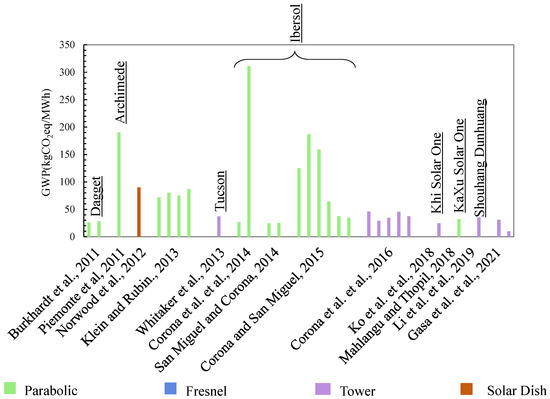
Figure 18.
Life cycle GHG emissions assessed in recent LCA analyses and published in the scientific literature [59,61,64,80,81,82,84,85,86,87,88,89,90].
Installation costs are often recognized as a primary impediment to the widespread adoption of CSP technology. In response to this challenge, numerous solutions have been put forth, from sophisticated modeling approaches to innovative system coupling strategies. In [33], published in Energy, the exploitation of CSP potentials was highest in the scenario without variable renewable energy (VRE) and decreased with the VRE share. With an increase in VRE share, wind power and PV gradually reduced the annual full-load hours of the CSP plants; at VRE shares of 40% and greater, this effect became particularly important. In [38], the authors propose a stochastic G&TEP model to analyze the cost of power systems with high renewable penetration: the paper emphasizes the role of CSP, shedding light on the technical and economical potentiality of the CSP when compared with thermal units.
Additionally, CSP increases the flexibility of the power system facilitating the penetration of VRE and reduces the electricity price [99]. However, the cost represents an important barrier to the diffusion of CSP technology. In particular, the outcomes of the literature review presented in this section highlight that, although CSP power systems have already been widely analyzed from the techno-economic and environmental perspective, these analyses have been carried out separately. Therefore, there is a strong need for an integrated approach that allows designers and planners to perform an overall sustainability assessment of the technology. For instance, economic and environmental optimization could be cross evaluated to select a design method that is shown to be the most sustainable from all perspectives.
5. Conclusions
The need to integrate renewable sources into the electricity and thermal energy production system has prompted researchers in recent decades to ask themselves which technology is better in terms of efficiency, CO2 reduction, economic competitiveness, and social acceptability. However, there is no single answer to these questions, but what currently emerges is that solar technologies are the most flexible and the simplest to use.
In recent years, great attention, both from industry and on the research side, has been paid to the development of CSP, which has many advantages over PV, especially for large size power-plants.
The high growth rate of publications motivated us to investigate the topic, using the support of the R software and its bibliometric package. Results, developed during the SOLARGRID project, have allowed us to clarify the state of the art and the maturity of this technology, as well as topics that have emerged through the study of the most influential authors and articles reviewed.
Our literature review has highlighted that the spread of CSP is hindered above all by economic parameters. In particular, the investment cost of CSP is still very high, as is the operation and maintenance cost. To overcome this important obstacle, technical, technological, and innovative alternatives have been identified. The first of these is the possibility of lowering the cost of energy produced by the CSP by considering supporting storage. This has a positive impact on flexibility and costs. Molten salts are the most common solution, though not an environment friendly one, especially when compared with solid storage or PCM storage. Corrosion represents a relevant aspect that is not to be underestimated with molten salts: it reduces the life span of the CSP and increase the costs Another solution is linked to increasing the efficiency of the system, which is further linked to the irradiance value and therefore is particularly relevant in the MESA regions. Moreover, the choice of hybrid configurations is improved when these include distributed energy storage systems. Examples are coupling CSP and PV technologies with poly-generation systems powered by conventional and non-conventional resources connected to the grid.
Finally, another solution is related to the size of the CSP. It has been demonstrated that, for large-sized plants, the cost of the energy produced becomes more convenient compared with the production of other renewable energy sources such as PV.
Moreover, from our literature review it also emerged that there are several parameters that can impact the diffusion of CSP technologies, these include the location, the land area occupancy, the consumption of the water, and other technological aspects. In detail, our results show that parabolic trough, Fresnel, tower, and dish technologies differ in several aspects, including land area occupancy and power range application. Parabolic trough systems typically have a moderate land footprint, requiring approximately 5 to 12 m2/MWh/y. They consist of long, curved solar collectors arranged in rows, and the area occupied is mostly linear. This technology is often used for medium- to large-scale power generation. These systems are capable of generating power in the range of tens to hundreds of megawatts.
Linear Fresnel systems have a similar linear layout to parabolic troughs, occupying a relatively moderate land area (land use ranging between 5 and 12 m2/MWh/y) and this technology is suited for medium-scale power generation. It can typically generate power in the range of tens to a few hundred megawatts.
Tower-based systems require a larger land area compared with trough and Fresnel systems, between 10 and 20 m2/MWh/y. They have a central tower surrounded by a field of heliostats or mirrors. This technology is often used for large-scale power generation. These systems can generate power ranging from hundreds of megawatts to several hundred megawatts.
Finally, solar dish systems have a small land footprint compared with the other CSP technologies, typically in the range of 1 to 5 m2/MWh/y. Each dish typically occupies a small area and can be mounted on a relatively small structure. Dish technology is commonly used for smaller-scale power generation and is well suited for distributed generation. The power output per dish is typically in the kilowatt to a few megawatts range.
It is important to note that these land use ranges are approximate and may vary significantly, depending on factors such as the specific technology design, solar resource availability, and the project’s layout efficiency.
In summary, parabolic trough and Fresnel find application for power ranges between 10 MW and 200 MW, tower for 10–150 MW and dish for small applications of less than 0.5 MW. Among the various existing CSP technologies, the parabolic trough (PTC) and the solar energy tower (SPT) are currently the two most widespread technologies. However, great attention in terms of future perspective is dedicated to the dish technology, especially because it can reach high temperatures, and from there improve the efficiency of the system. However, this technology presents some important limitations, the primary of which is its high cost.
Additional prospective research areas within the CSP domain encompass economic optimization concerning both installation and operational expenses, the incorporation of life cycle assessment (LCA), the integration of organic Rankine cycle (ORC) engines for combined heat and power generation, the analysis of calcium circuit performance, and the exploration of thermochemical energy storage within CSP systems. Furthermore, upcoming avenues for research involve the exploration of desalination, hydrogen production, life cycle assessment, and the implementation of phase-change materials (PCMs), which are poised to constitute the next phase of future investigations in this field. Finally, new research must be implemented, such as the possibility of producing green hydrogen with CSP, the use of PCM for thermal storage, and the possibility of implementing new hybrid configurations in which the CSP is coupled with renewable or traditional plants, and whose advantages and disadvantages are linked to the particular situation being examined.
Among the main limits, water scarcity represents an important barrier to CSP technology. In fact, limited water resource availability at potentially suitable locations for concentrated solar thermal power (CSP) is a critical challenge. On one hand, introducing water to the cooling system and mirror cleaning significantly increases the overall CSP plant efficiency and its cost-effectiveness, considering the generally low cost of water. On the other hand, the high water consumption rate of these processes influences the local water resources and consequently also limits the suitable sites for new plants. Therefore, there is a need to find alternative solutions that can optimize the use of water resources and reduce performance penalties. This requires, first, a better understanding of water consumption mechanisms.
Author Contributions
All of the authors actively contributed to the drafting of the paper and enriched it with their suggestions and in-depth knowledge on the topic. However, their specific contributions are highlighted below. Conceptualization, G.F., C.D., A.B., V.D.D., M.D.S. and S.L.; methodology, G.F., C.D., S.G. and S.L.; formal analysis: P.C., G.F., S.G., F.R., M.L.P. and A.S.; investigation, all authors; resources, F.R., M.L.P. and A.S.; writing—original draft preparation, all authors; writing—review and editing, all authors; supervision, V.D.D., A.B. and G.F.; funding acquisition, C.D. and G.F. All authors have read and agreed to the published version of the manuscript.
Funding
The work is part of the Research and Innovation Project “Solargrid: Sistemi sOlari termodinamici e fotovoLtaici con Accumulo peR co-GeneRazIone e flessibilità Di rete”—cod. ARS01_00532. The project has been jointly funded by the European Union and Italian Research and University Ministry (MIUR) under the Programma Operativo Nazionale “Ricerca e Innovazione” 2014–2020 (PON “R&I” 2014–2020).
Data Availability Statement
Data are contained within the article.
Conflicts of Interest
The authors declare no conflict of interest.
Abbreviations
| CSP | Concentrating solar power |
| CPV | Concentrated photovoltaics |
| DER | Distributed energy resources |
| DG | Distributed generation |
| DNI | Direct normal irradiance |
| GHG | Greenhouse gas |
| GWP | Global warming potential |
| IRENA | International renewable energy agency |
| LCA | Life cycle analysis |
| LCI | Life cycle inventory |
| LCIA | Life cycle impact assessment |
| LCOE | Levelized cost of electricity |
| MENA | Middle East and North Africa |
| PCU | Power conversion unit |
| PV | Photovoltaic |
| RES | Renewable energy sources |
| Solar PACES | Solar power and chemical energy systems |
| VRE | Variable renewable energy |
References
- Chicco, G.; Di Somma, M.; Graditi, G. Chapter 1—Overview of Distributed Energy Resources in the Context of Local Integrated Energy systems. In Distributed Energy Resources in Local Integrated Energy Systems; Elsevier: Amsterdam, The Netherlands, 2021; pp. 1–29. ISBN 9780128238998. [Google Scholar] [CrossRef]
- Di Somma, M.; Falvo, M.C.; Graditi, G.; Manganelli, M.; Scanzano, M.; Valenti, M. Integration of renewable energy source in transmission grids: Issues and perspectives. In Proceedings of the 2021 IEEE International Conference on Environment and Electrical Engineering and 2021 IEEE Industrial and Commercial Power Systems Europe (EEEIC/I&CPS Europe), Bari, Italy, 7–10 September 2021; pp. 1–8. [Google Scholar]
- Ciavarella, R.; Di Somma, M.; Graditi, G.; Valenti, M. Smart Grids for the Efficient Management of Distributed Energy Resources. In Technologies for Integrated Energy Systems and Networks; Graditi, G., Di Somma, M., Eds.; John Wiley & Sons, Inc.: New York, NY, USA, 2022. [Google Scholar] [CrossRef]
- Ciavarella, R.; Di Somma, M.; Graditi, G.; Valenti, M. Congestion Management in distribution grid networks through active power control of flexible distributed energy resources. In Proceedings of the 2019 IEEE Milan PowerTech, Milan, Italy, 23–27 June 2019; pp. 1–6. [Google Scholar] [CrossRef]
- Patsalides, M.; Papadimitriou, C.N.; Efthymiou, V.; Ciavarella, R.; Di Somma, M.; Wakszyńska, A.; Kosmecki, M.; Graditi, G.; Valenti, M. Frequency Stability Evaluation in Low Inertia Systems Utilizing Smart Hierarchical Controllers. Energies 2020, 13, 3506. [Google Scholar] [CrossRef]
- Zhang, X.; Dong, X.; Li, X. Study of China’s Optimal Concentrated Solar Power Development Path to 2050. Front. Energy Res. 2021, 9, 724021. [Google Scholar] [CrossRef]
- Goyal, N.; Aggarwal, A.; Kumar, A. Concentrated solar power plants: A critical review of regional dynamics and operational parameters. Energy Res. Soc. Sci. 2022, 83, 102331. [Google Scholar] [CrossRef]
- Pazheri, F.; Othman, M.; Malik, N. A review on global renewable electricity scenario. Renew. Sustain. Energy Rev. 2014, 31, 835–845. [Google Scholar] [CrossRef]
- IRENA International Renewable Energy Agency. Renewable Energy Statistics 2022; IRENA: Abu Dhabi, United Arab Emirates, 2022. [Google Scholar]
- Schmela, M.; Rossi, R.; Lits, C.; Chunduri, S.K.; Shah, A.; Muthyal, R.; Moghe, P.; Kalam, S.; Jamkhedkar, A.; Goel, S.; et al. Advancements in solar technology, markets, and investments—A summary of the 2022 ISA World Solar Reports. Sol. Compass 2023, 6, 100045. [Google Scholar] [CrossRef]
- Soria, R.; Lucena, A.F.P.; Tomaschek, J.; Fichter, T.; Haasz, T.; Szklo, A.; Schaeffer, R.; Rochedo, P.; Fahl, U.; Kern, J.; et al. The role of CSP in Brazil: A multi-model analysis. AIP Conf. Proc. 2016, 1734, 110004. [Google Scholar]
- Blanc, P.; Espinar, B.; Geuder, N.; Gueymard, C.; Meyer, R.; Pitz-Paal, R.; Reinhardt, B.; Renné, D.; Sengupta, M.; Wald, L.; et al. Direct normal irradiance related definitions and applications: The circumsolar issue. Sol. Energy 2014, 110, 561–577. [Google Scholar] [CrossRef]
- Liu, Y.; Li, F.; Ren, J.; Ren, G.; Shen, H.; Liu, G. Solar thermal Power Generation Technology Research. E3S Web Conf. 2019, 136, 02016. [Google Scholar] [CrossRef]
- Chien, J.C.L.; Lior, N. Concentrating Solar thermal Power as a Viable Alternative in China’s Electricity Supply. Energy Policy 2011, 39, 7622–7636. [Google Scholar] [CrossRef]
- Lovegrove, K.; Stein, W. Concentrating Solar Power Technology: Principles, Developments and Applications; Woodhead Publushing: Sawston, UK, 2012. [Google Scholar] [CrossRef]
- Singh, G. Solar power generation by PV (photovoltaic) technology: A review. Energy 2013, 53, 1–13. [Google Scholar] [CrossRef]
- Pelay, U.; Luo, L.; Fan, Y.; Stitou, D.; Rood, M. Thermal Energy Storage Systems for Concentrated Solar Power Plants. Renew. Sustain. Energy Rev. 2017, 79, 82–100. [Google Scholar] [CrossRef]
- Hussain, A.; Arif, S.M.; Aslam, M. Emerging renewable and sustainable energy technologies: State of the art. Renew. Sustain. Energy Rev. 2017, 71, 12–28. [Google Scholar] [CrossRef]
- Calderón, A.; Barreneche, C.; Prieto, C.; Segarra, M.; Fernández, A.I. Concentrating Solar Power Technologies: A Bibliometric Study of Past, Present and Future Trends in Concentrating Solar Power Research. Front. Mech. Eng. 2021, 7, 682592. [Google Scholar] [CrossRef]
- Aria, M.; Cuccurullo, C. bibliometrix: An R-tool for comprehensive science mapping analysis. J. Informetr. 2017, 11, 959–975. [Google Scholar] [CrossRef]
- Zhang, J.; Yu, Q.; Zheng, F.; Long, C.; Lu, Z.; Duan, Z. Comparing keywords plus of WOS and Authors keywords: A case study of aherence research. J. Assoc. Inf. Sci. Technol. 2015, 67, 967–972. [Google Scholar] [CrossRef]
- Social Network Analysis and Visualization, White Paper, Cambridge Intelligence. Available online: https://cambridge-intelligence.com/keylines-faqs-social-network-analysis/ (accessed on 2 January 2020).
- Ren, L.-Z.; Yu, X.-X.; Zhang, Y.-Z. Cost-benefit evolution for concentrated solar power in China. J. Clean. Prod. 2018, 190, 471–482. [Google Scholar] [CrossRef]
- Hang, Q.; Jun, Z.; Xiao, Y.; Junkui, C. Prospect of concentrating solar power in China—The sustainable future. Renew. Sustain. Energy Rev. 2008, 12, 2505–2514. [Google Scholar] [CrossRef]
- Shahsavari, A.; Akbari, M. Potential of solar energy in developing countries for reducing energy-related emissions. Renew. Sustain. Energy Rev. 2018, 90, 275–291. [Google Scholar] [CrossRef]
- Weinstein, L.A.; Loomis, J.; Bhatia, B.; Bierman, D.M.; Wang, E.N.; Chen, G. Concentrating Solar Power. Chem. Rev. 2015, 115, 12797–12838. [Google Scholar] [CrossRef]
- Fuqiang, W.; Ziming, C.; Jianyu, T.; Yuan, Y.; Yong, S.; Linhua, L. Progress in concentrated solar power technology with parabolic trough collector system: A comprehensive review. Renew. Sustain. Energy Rev. 2017, 79, 1314–1328. [Google Scholar] [CrossRef]
- Khan, J.; Arsalan, M.H. Solar power technologies for sustainable electricity generation—A review. Renew. Sustain. Energy Rev. 2016, 55, 414–425. [Google Scholar] [CrossRef]
- Hernández-Moro, J.; Martínez-Duart, J. Analytical model for solar PV and CSP electricity costs: Present LCOE values and their future evolution. Renew. Sustain. Energy Rev. 2013, 20, 119–132. [Google Scholar] [CrossRef]
- Carrillo, A.J.; González-Aguilar, J.; Romero, M.; Coronado, J.M. Solar Energy on Demand: A Review on High Temperature Thermochemical Heat Storage Systems and Materials. Chem. Rev. 2019, 119, 4777–4816. [Google Scholar] [CrossRef] [PubMed]
- Padilla, R.V.; Too, Y.C.S.; Benito, R.; Stein, W. Exergetic analysis of supercritical CO2 Brayton cycles integrated with solar central receivers. Appl. Energy 2015, 148, 348–365. [Google Scholar] [CrossRef]
- Ahmadi, M.H.; Ghazvini, M.; Sadeghzadeh, M.; Alhuyi Nazari, M.; Kumar, R.; Naeimi, A.; Ming, T. Solar power technology for electricity generation: A critical review. Energy Sci. Eng. 2018, 6, 340–361. [Google Scholar] [CrossRef]
- Chacartegui, R.; Alovisio, A.; Ortiz, C.; Valverde, J.; Verda, V.; Becerra, J. Thermochemical energy storage of concentrated solar power by integration of the calcium looping process and a CO2 power cycle. Appl. Energy 2016, 173, 589–605. [Google Scholar] [CrossRef]
- Asdrubali, F.; Baldinelli, G.; D’alessandro, F.; Scrucca, F. Life cycle assessment of electricity production from renewable energies: Review and results harmonization. Renew. Sustain. Energy Rev. 2015, 42, 1113–1122. [Google Scholar] [CrossRef]
- Gils, H.C.; Scholz, Y.; Pregger, T.; de Tena, D.L.; Heide, D. Integrated modelling of variable renewable energy-based power supply in Europe. Energy 2017, 123, 173–188. [Google Scholar] [CrossRef]
- Al Garni, H.; Kassem, A.; Awasthi, A.; Komljenovic, D.; Al-Haddad, K. A multicriteria decision making approach for evaluating renewable power generation sources in Saudi Arabia. Sustain. Energy Technol. Assess. 2016, 16, 137–150. [Google Scholar] [CrossRef]
- Zhu, G.; Wendelin, T.; Wagner, M.J.; Kutscher, C. History, current state, and future of linear Fresnel concentrating solar collectors. Sol. Energy 2014, 103, 639–652. [Google Scholar] [CrossRef]
- Sansaniwal, S.K.; Sharma, V.; Mathur, J. Energy and exergy analyses of various typical solar energy applications: A comprehensive review. Renew. Sustain. Energy Rev. 2018, 82, 1576–1601. [Google Scholar] [CrossRef]
- Pacio, J.; Wetzel, T. Assessment of liquid metal technology status and research paths for their use as efficient heat transfer fluids in solar central receiver systems. Sol. Energy 2013, 93, 11–22. [Google Scholar] [CrossRef]
- Du, E. The Role of Concentrating Solar Power Toward High Renewable Energy Penetrated Power Systems. IEEE Trans. Power Syst. 2018, 33, 6630–6641. [Google Scholar] [CrossRef]
- Behar, O.; Khellaf, A.; Mohammedi, K. A novel parabolic trough solar collector model—Validation with experimental data and comparison to Engineering Equation Solver (EES). Energy Convers. Manag. 2015, 106, 268–281. [Google Scholar] [CrossRef]
- Dominković, D.; Bačeković, I.; Ćosić, B.; Krajačić, G.; Pukšec, T.; Duić, N.; Markovska, N. Zero carbon energy system of South East Europe in 2050. Appl. Energy 2016, 184, 1517–1528. [Google Scholar] [CrossRef]
- Aly, A.; Jensen, S.S.; Pedersen, A.B. Solar power potential of Tanzania: Identifying CSP and PV hot spots through a GIS multicriteria decision making analysis. Renew. Energy 2017, 113, 159–175. [Google Scholar] [CrossRef]
- Buscemi, A.; Guarino, S.; Ciulla, G.; Brano, V.L. A methodology for optimisation of solar dish-Stirling systems size, based on the local frequency distribution of direct normal irradiance. Appl. Energy 2021, 303, 117681. [Google Scholar] [CrossRef]
- Machinda, G.T.; Arscott, R.; Chowdhury, S.P.; Kibaara, S. Concentrating solar thermal power technologies: A review. In Proceedings of the 2011 Annual IEEE India Conference, Hyderabad, India, 16–18 December 2011; pp. 1–6. [Google Scholar]
- Zhang, H.; Baeyens, J.; Degrève, J.; Cacères, G. Concentrated solar power plants: Review and design methodology. Renew. Sustain. Energy Rev. 2013, 22, 466–481. [Google Scholar] [CrossRef]
- Islam, M.T.; Huda, N.; Abdullah, A.B.; Saidur, R. A comprehensive review of state-of-the-art concentrating solar power (CSP) technologies: Current status and research trends. Renew. Sustain. Energy Rev. 2018, 91, 987–1018. [Google Scholar] [CrossRef]
- Trieb, F. Global potential of concentrating solar power. In Proceedings of the SolarPACES Conferences, Berlin, Germany, 15–18 September 2009. [Google Scholar]
- Van Sark, W.; Corona, B. Concentrating Solar Power—Chapter 12. In Technological Learning in the Transition to a Low-Carbon Energy System; Junginger, M., Louwen, A., Eds.; Academic Press: Cambridge, MA, USA, 2020; pp. 221–231. ISBN 9780128187623. [Google Scholar] [CrossRef]
- National Renewable Energy Laboratory. Concentrating Solar Power Projects n.d. Available online: https://solarpaces.nrel.gov/ (accessed on 2 January 2020).
- Mancini, T.; Heller, P.; Butler, B.; Osborn, B.; Schiel, W.; Goldberg, V.; Buck, R.; Diver, R.; Andraka, C.; Moreno, J. Dish-stirling systems: An overview of development and status. J. Sol. Energy Eng. 2003, 125, 135–151. [Google Scholar] [CrossRef]
- Guarino, S.; Buscemi, A.; Ciulla, G.; Bonomolo, M.; Brano, V.L. A dish-stirling solar concentrator coupled to a seasonal thermal energy storage system in the southern mediterranean basin: A cogenerative layout hypothesis. Energy Convers. Manag. 2020, 222, 113228. [Google Scholar] [CrossRef]
- Gu, L.; Li, Y.; Zhong, S.; Shen, R.; Zheng, R.; Yang, D.; Zhao, J.; Li, H. Theoretical and experimental study on the heat collection of solar dish system based on adjustable receiver. Energy Convers. Manag. 2023, 291, 117250. [Google Scholar] [CrossRef]
- Buscemi, A.; Brano, V.L.; Chiaruzzi, C.; Ciulla, G.; Kalogeri, C. A validated energy model of a solar dish-Stirling system considering the cleanliness of mirrors. Appl. Energy 2020, 260, 114378. [Google Scholar] [CrossRef]
- Musi, R.; Grange, B.; Sgouridis, S.; Guedez, R.; Armstrong, P.; Calvet, N.; Slocum, A. Techno-Economic Analysis of Concentrated Solar Power Plants in Terms of Levelized Cost of Electricity. In AIP Conference Proceedings, Proceeding of the SOLARPACES 2016: International Conference on Concentrating Solar Power and Chemical Energy Systems, Abu Dhabi, United Arab Emirates, 11–14 October 2016; AIP Publishing: College Park, MD, USA, 2017; Volume 1850, p. 160018. [Google Scholar] [CrossRef]
- Zhao, Z.-Y.; Chen, Y.-L.; Thomson, J.D. Levelized cost of energy modeling for concentrated solar power projects: A China study. Energy 2017, 120, 117–127. [Google Scholar] [CrossRef]
- Chad, A.; Kesseli, D.; Turchi, C. Technoeconomic Cost Analysis of NREL Concentrating Solar Power Gen3 Liquid Pathway: Preprint. Golden, CO: National Renewable Energy Laboratory. NREL/CP-5500-77852. 2021. Available online: https://www.nrel.gov/docs/fy22osti/77852.pdf (accessed on 2 January 2020).
- Enjavi-Arsanjani, M.; Hirbodi, K.; Yaghoubi, M. Solar Energy Potential and Performance Assessment of CSP Plants in Different Areas of Iran. Energy Procedia 2015, 69, 2039–2048. [Google Scholar] [CrossRef]
- Corona, B.; Ruiz, D.; San Miguel, G. Life Cycle Assessment of a HYSOL Concentrated Solar Power Plant: Analyzing the Effect of Geographic Location. Energies 2016, 9, 413. [Google Scholar] [CrossRef]
- Spyridonidou, S.; Vagiona, D.G. A systematic review of site-selection procedures of PV and CSP technologies. Energy Rep. 2023, 9, 2947–2979. [Google Scholar] [CrossRef]
- Corona, B.; Miguel, G.S. Environmental analysis of a Concentrated Solar Power (CSP) plant hybridised with different fossil and renewable fuels. Fuel 2015, 145, 63–69. [Google Scholar] [CrossRef]
- Ju, X.; Xu, C.; Hu, Y.; Han, X.; Wei, G.; Du, X. A review on the development of photovoltaic/concentrated solar power (PV-CSP) hybrid systems. Sol. Energy Mater. Sol. Cells 2017, 161, 305–327. [Google Scholar] [CrossRef]
- Powell, K.M.; Rashid, K.; Ellingwood, K.; Tuttle, J.; Iverson, B.D. Hybrid concentrated solar thermal power systems: A review. Renew. Sustain. Energy Rev. 2017, 80, 215–237. [Google Scholar] [CrossRef]
- Gasa, G.; Lopez-Roman, A.; Prieto, C.; Cabeza, L.F. Life Cycle Assessment (LCA) of a Concentrating Solar Power (CSP) Plant in Tower Configuration with and without Thermal Energy Storage (TES). Sustainability 2021, 13, 3672. [Google Scholar] [CrossRef]
- Palacios, A.; Barreneche, C.; Navarro, M.; Ding, Y. Thermal energy storage technologies for concentrated solar power—A review from a materials perspective. Renew. Energy 2020, 156, 1244–1265. [Google Scholar] [CrossRef]
- Alnaimat, F.; Rashid, Y. Thermal Energy Storage in Solar Power Plants: A Review of the Materials, Associated Limitations, and Proposed Solutions. Energies 2019, 12, 4164. [Google Scholar] [CrossRef]
- Cannone, S.F.; Lanzini, A.; Stendardo, S. An Innovative Calcium Looping Process as Energy Storage System Integrated With a Solar-Powered Supercritical CO2 Brayton Cycle. Front. Sustain. 2021, 2, 740105. [Google Scholar] [CrossRef]
- Desideri, U.; Zepparelli, F.; Morettini, V.; Garroni, E. Comparative Analysis of Concentrating Solar Power and Photovoltaic Technologies: Technical and Environmental Evaluations. Appl. Energy 2013, 102, 765–784. [Google Scholar] [CrossRef]
- Alami, A.H.; Olabi, A.; Mdallal, A.; Rezk, A.; Radwan, A.; Rahman, S.M.A.; Shah, S.K.; Abdelkareem, M.A. Concentrating solar power (CSP) technologies: Status and analysis. Int. J. Thermofluids 2023, 18, 100340. [Google Scholar] [CrossRef]
- Chaanaoui, M.; Vaudreuil, S.; Bounahmidi, T. Benchmark of Concentrating Solar Power Plants: Historical, Current and Future Technical and Economic Development. Procedia Comput. Sci. 2016, 83, 782–789. [Google Scholar] [CrossRef]
- Mohammadi, K.; Saghafifar, M.; Ellingwood, K.; Powell, K. Hybrid concentrated solar power (CSP)-desalination systems: A review. Desalination 2019, 468, 114083. [Google Scholar] [CrossRef]
- Abouaziza, F.; Issam, D.; Hedi, D. Concentrating solar power (CSP)-desalination systems: A review. Int. J.Chem. Mater. Environ. Res. (IJCMER) 2022, 8, 12–20. [Google Scholar]
- Shalaby, S.; Hammad, F.A.; Zayed, M.E. Current progress in integrated solar desalination systems: Prospects from coupling configurations to energy conversion and desalination processes. Process. Saf. Environ. Prot. 2023, 178, 494–510. [Google Scholar] [CrossRef]
- Boudries, R. Techno-economic study of hydrogen production using CSP technology. Int. J. Hydrogen Energy 2018, 43, 3406–3417. [Google Scholar] [CrossRef]
- Rosenstiel, A.; Monnerie, N.; Dersch, J.; Roeb, M.; Pitz-Paal, R.; Sattler, C. Electrochemical Hydrogen Production Powered by PV/CSP Hybrid Power Plants: A Modelling Approach for Cost Optimal System Design. Energies 2021, 14, 3437. [Google Scholar] [CrossRef]
- ISO 14040:2021; International Standards Organization Environmental Management—Life Cycle Assessment—Principles and Framework. ISO: Geneva, Switzerland, 2021.
- UNI EN ISO 14044:2021; Environmental Management—Life Cycle Assessment—Re-Quirements and Guidelines. International Standards Organization: Geneva, Switzerland, 2021.
- Wernet, G.; Bauer, C.; Steubing, B.; Reinhard, J.; Moreno-Ruiz, E.; Weidema, B. The ecoinvent database version 3 (part I): Overview and methodology. Int. J. Life Cycle Assess. 2016, 21, 1218–1230. [Google Scholar] [CrossRef]
- Kuenlin, A.; Augsburger, G.; Gerber, L.; Maréchal, F. Life Cycle Assessment and Environomic Optimization of Concentrating Solar Thermal Power Plants. In Proceedings of the 26th International Conference on Efficiency, Cost, Optimization, Simulation and Environmental Impact of Energy Systems (ECOS2013), Guilin, China, 16–19 July 2013. [Google Scholar]
- Corona, B.; Miguel, G.S.; Cerrajero, E. Life Cycle Assessment of Concentrated Solar Power (CSP) and the Influence of Hybridising with Natural Gas. Int. J. Life Cycle Assess. 2014, 19, 1264–1275. [Google Scholar] [CrossRef]
- Miguel, G.S.; Corona, B. Hybridizing Concentrated Solar Power (CSP) with Biogas and Biomethane as an Alternative to Natural Gas: Analysis of Environmental Perfor-mance Using LCA. Renew. Energy 2014, 66, 580–587. [Google Scholar] [CrossRef]
- Burkhardt, J.J.; Heath, G.A.; Turchi, C.S. Life Cycle Assessment of a Parabolic Trough Concentrating Solar Power Plant and the Impacts of Key Design Alternatives. Environ. Sci. Technol. 2011, 45, 2457–2464. [Google Scholar] [CrossRef] [PubMed]
- Burkhardt, J.J.; Heath, G.; Cohen, E. Life Cycle Greenhouse Gas Emissions of Trough and Tower Concentrating Solar Power Electricity Generation: Systematic Review and Harmonization. J. Ind. Ecol. 2012, 16, S93–S109. [Google Scholar] [CrossRef]
- Whitaker, M.B.; Heath, G.A.; Burkhardt, J.J.; Turchi, C.S. Life Cycle Assessment of a Power Tower Concentrating Solar Plant and the Impacts of Key Design Alternatives. Environ. Sci. Technol. 2013, 47, 5896–5903. [Google Scholar] [CrossRef]
- Piemonte, V.; De Falco, M.; Tarquini, P.; Giaconia, A. Life Cycle Assessment of a High Temperature Molten Salt Concentrated Solar Power Plant. Sol. Energy 2011, 85, 1101–1108. [Google Scholar] [CrossRef]
- Ko, N.; Lorenz, M.; Horn, R.; Krieg, H.; Baumann, M. Sustainability Assessment of Concentrated Solar Power (CSP) Tower Plants—Integrating LCA, LCC and LCWE in One Framework. Procedia CIRP 2018, 69, 395–400. [Google Scholar] [CrossRef]
- Mahlangu, N.; Thopil, G.A. Analysis of External Costs of a Parabolic Trough Concentrated Solar Power Plant. J. Clean. Prod. 2018, 195, 32–43. [Google Scholar] [CrossRef]
- Li, R.; Zhang, H.; Wang, H.; Tu, Q.; Wang, X. Integrated Hybrid Life Cycle Assessment and Contribution Analysis for CO2 Emission and Energy Consumption of a Concentrated Solar Power Plant in China. Energy 2019, 174, 310–322. [Google Scholar] [CrossRef]
- Norwood, Z.; Kammen, D. Life Cycle Analysis of Distributed Concentrating Solar Combined Heat and Power: Economics, Global Warming Potential and Water. Environ. Res. Lett. 2012, 7, 044016. [Google Scholar] [CrossRef]
- Klein, S.J.; Rubin, E.S. Life Cycle Assessment of Greenhouse Gas Emissions, Water and Land Use for Concentrated Solar Power Plants with Different Energy Backup Systems. Energy Policy 2013, 63, 935–950. [Google Scholar] [CrossRef]
- Ehtiwesh, I.A.; Coelho, M.C.; Sousa, A.C. Exergetic and Environmental Life Cycle Assessment Analysis of Concentrated Solar Power Plants. Renew. Renew. Sustain. Energy Rev. 2016, 56, 145–155. [Google Scholar] [CrossRef]
- Adeoye, J.T.; Amha, Y.M.; Poghosyan, V.H.; Torchyan, K.; Arafat, H.A. Comparative LCA of Two Thermal Energy Storage Systems for Shams1 Concentrated Solar Power Plant: Molten Salt vs. Concrete. J. Clean Energy Technol. 2014, 2, 274–281. [Google Scholar] [CrossRef]
- Cucumo, M.; Ferraro, V.; Marinelli, V.; Cucumo, S.; Cucumo, D. Lca Analysis of a Solar Concentration System for the Micro-Chp and Comparison with a Pv Plant. Int. J. Heat Technol. 2012, 30, 63–68. [Google Scholar]
- Moosavian, S.F.; Borzuei, D.; Ahmadi, A. Energy, Exergy, Environmental and Economic Analysis of the Parabolic Solar Collector with Life Cycle Assessment for Different Climate Condi-tions. Renew. Energy 2020, 165, 301–320. [Google Scholar] [CrossRef]
- Kommalapati, R.; Kadiyala, A.; Shahriar, T.; Huque, Z. Review of the Life Cycle Greenhouse Gas Emissions from Different Photovoltaic and Concentrating Solar Power Electricity Generation Systems. Energies 2017, 10, 350. [Google Scholar] [CrossRef]
- Lamnatou, C.; Chemisana, D. Concentrating Solar Systems: Life Cycle Assessment (LCA) and Environmental Issues. Renew. Sustain. Energy Rev. 2017, 78, 916–932. [Google Scholar] [CrossRef]
- Caldés, N.; Lechón, Y. Socio-Economic and Environmental Assessment of Concentrating Solar Power Systems. In Concentrating Solar Power Technology; Woodhead Publishing: Sawston, UK, 2021; ISBN 9780128199701. [Google Scholar]
- Guillén-Lambea, S.; Carvalho, M. A Critical Review of the Greenhouse Gas Emissions Associated with Parabolic Trough Concentrating Solar Power Plants. J. Clean. Prod. 2021, 289, 125774. [Google Scholar] [CrossRef]
- Bâra, A.; Oprea, S.-V.; Băroiu, A.-C. Forecasting the Spot Market Electricity Price with a Long Short-Term Memory Model Architecture in a Disruptive Economic and Geopolitical Context. Int. J. Comput. Intell. Syst. 2023, 16, 130. [Google Scholar] [CrossRef]
Disclaimer/Publisher’s Note: The statements, opinions and data contained in all publications are solely those of the individual author(s) and contributor(s) and not of MDPI and/or the editor(s). MDPI and/or the editor(s) disclaim responsibility for any injury to people or property resulting from any ideas, methods, instructions or products referred to in the content. |
© 2023 by the authors. Licensee MDPI, Basel, Switzerland. This article is an open access article distributed under the terms and conditions of the Creative Commons Attribution (CC BY) license (https://creativecommons.org/licenses/by/4.0/).